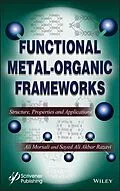Owing to the extensive interest in construction of functional metal organic frameworks (FMOFs), this book discusses the roles of functional groups on the structure and application of metal organic frameworks (MOFs). The contents of the book are classified based on the structural and chemical properties of organic functions, in order to make readers able to compare the different effects of each function on the structure and application of the MOFs.
In each chapter, the chemical properties of applied functional groups are gathered to give deeper insight into the roles of organic functions in the structure and application of MOFs. In the function-application properties, the authors discuss how a functional group can dominate the host-guest chemistry of the MOFs and how this host-guest chemistry can expand the effectiveness and efficiency of the material in different fields of applications. Finally, function-structure properties are discussed. In function-application properties, it is discussed how a functional group can affect the topology, porosity, flexibility and stability of the framework. The features of this subject are novel and are presented for the first time.
Autorentext
Audience
This book is interesting to a diverse group of scientists, including chemists, materials scientists, chemical engineers and any scientist who is working on supramolecular chemistry of MOFs and designing functional materials.
Ali Morsali is Master in Inorganic Chemistry in Tarbiat Modares University, Tehran, Iran. He obtained his PhD in 2003 in Inorganic Chemistry from the same university. He has published more than 400 articles in international journals as well as 5 patents. He has received numerous national awards. Amongst his research interests are coordination chemistry and metal-organic frameworks. He is the co-author of Main Group Metal Coordination Polymers and Pillared Metal-Organic Frameworks (Wiley-Scrivener 2017, 2019 respectively).
Sayed Ali Akbar Razavi received his BSc in pure chemistry in 2014 from Sharif University of Technology and his MSc in inorganic chemistry in 2017 from Tarbiat Modares University, Tehran, Iran. Currently, he is a PhD student under supervision of Prof. Ali Morsali. His research interest focuses on functional metalorganic frameworks.
Klappentext
This book comprehensively reviews the literature to illuminate deep insight about the effects of linker functionalization on structure and host-guest chemistry of functional metal organic frameworks (FMOFs).
Owing to the extensive interest in construction of functional metal organic frameworks (FMOFs), this book discusses the roles of functional groups on the structure and application of metal organic frameworks (MOFs). The contents of the book are classified based on the structural and chemical properties of organic functions, in order to make readers able to compare the different effects of each function on the structure and application of the MOFs.
In each chapter, the chemical properties of applied functional groups are gathered to give deeper insight into the roles of organic functions in the structure and application of MOFs. In the function-application properties, the authors discuss how a functional group can dominate the host-guest chemistry of the MOFs and how this host-guest chemistry can expand the effectiveness and efficiency of the material in different fields of applications. Finally, function-structure properties are discussed. In function-application properties, it is discussed how a functional group can affect the topology, porosity, flexibility and stability of the framework. The features of this subject are novel and are presented for the first time.
Inhalt
Preface ix
1 Introduction to Functional MetalOrganic Frameworks 1
1.1 Coordination Polymers 1
1.2 MetalOrganic Frameworks 4
1.3 Functional MetalOrganic Frameworks 6
References 11
2 Amine Decorated MetalOrganic Frameworks 15
2.1 General Chemical Properties of Amine Function 15
2.2 FunctionApplication Properties 16
2.3 FunctionStructure Properties 30
References 31
3 Azo and Azine Decorated MetalOrganic Frameworks 37
3.1 General Chemical Properties of Azine and Azo Functions 37
3.2 FunctionApplication Properties 37
3.3 Function-Structure Properties 47
References 50
4 Imidazolium and Pyridinium Decorated Metal-Organic Frameworks 55
4.1 Imidazolium Functionalized MetalOrganic Frameworks 55
4.1.1 General Chemical Properties of Imidazolium Function 55
4.1.2 FunctionApplication Properties 56
4.1.3 FunctionStructure Properties 63
4.2 Pyridinium Functionalized MetalOrganic Frameworks 64
4.2.1 General Chemical Properties of Pyridinium Function 64
4.2.2 FunctionApplication Properties 65
4.2.3 FunctionStructure Properties 71
References 72
5 Heterocyclic Azine Decorated Metal-Organic Frameworks 79
5.1 General Chemical Properties of Heterocyclic Azine Functions 79
5.2 FunctionApplication Properties 81
5.3 FunctionStructure Properties 95
References 100
6 Heterocyclic Azole Decorated Metal-Organic Frameworks 107
6.1 General Chemical Properties of Heterocyclic Azole Functions 107
6.2 FunctionApplication Properties 108
6.3 FunctionStructure Properties 118
References 125
7 Functional MetalOrganic Frameworks by Oxygen and Sulfur Based Functions 133
7.1 Functionalized MetalOrganic Frameworks by Oxygen Based Functions 133
7.1.1 FunctionApplication Properties 133
7.1.2 FunctionStructure Properties 140
7.2 Functionalized MetalOrganic Frameworks by Sulfur Based Functions 142
7.2.1 Functionalized MetalOrganic Frameworks by Thiol and Sulfide Functions 142
7.2.2 Functionalized MetalOrganic Frameworks by Sulfonate-Sulfonic Acid Function 149
7.2.3 Functionalized MetalOrganic Frameworks by Other S-Based Functions 155
References 156
8 Urea and Amide Decorated Metal-Organic Frameworks 165
8.1 Functionalized MetalOrganic Frameworks by Amide Function 166
8.1.1 General Chemical Properties of Amide Function 166
8.1.2 FunctionApplication Properties 166
8.1.3 FunctionStructure Properties 178
8.2 Functionalized MetalOrganic Frameworks by Urea Function 180
8.2.1 General Chemical Properties of Urea Function 180
8.2.2 FunctionApplication Properties 182
8.2.3 StructureFunction Properties 186
8.3 Functionalized MetalOrganic Frameworks by Squaramide Function 189
References 192
9 Carbonyl, Carboxy and Imide Functionalized MetalOrganic Frameworks 201
9.1 Functionalized MetalOrganic Frameworks by Carbonyl Function 201
9.1.1 General Chemical Properties of Carbonyl Functional Group 201
9.1.2 FunctionApplication Properties 202
9.1.3 FunctionStructure Properties 206
9.2 Functionalized MetalOrganic Frameworks by Carboxy Function 207
9.2.1 General Chemical Properties of Carboxy Function 207
9.2.2 Synthesis of Functionalized Metal-Organic Frameworks with Free Carboxy Function 208
9.2.3 FunctionApplication Properties 209
9.2.4 FunctionStructure Properties 213
9.3 Functionalized MetalOrganic Frameworks by Imide Function 216
9.3.1 General Chemical Properties of Imide Function 216
9.3.2 FunctionApplication Properties 218
References 224
10 Fluorine and Phosphonate Functional MetalOrganic Frameworks 231
10...
